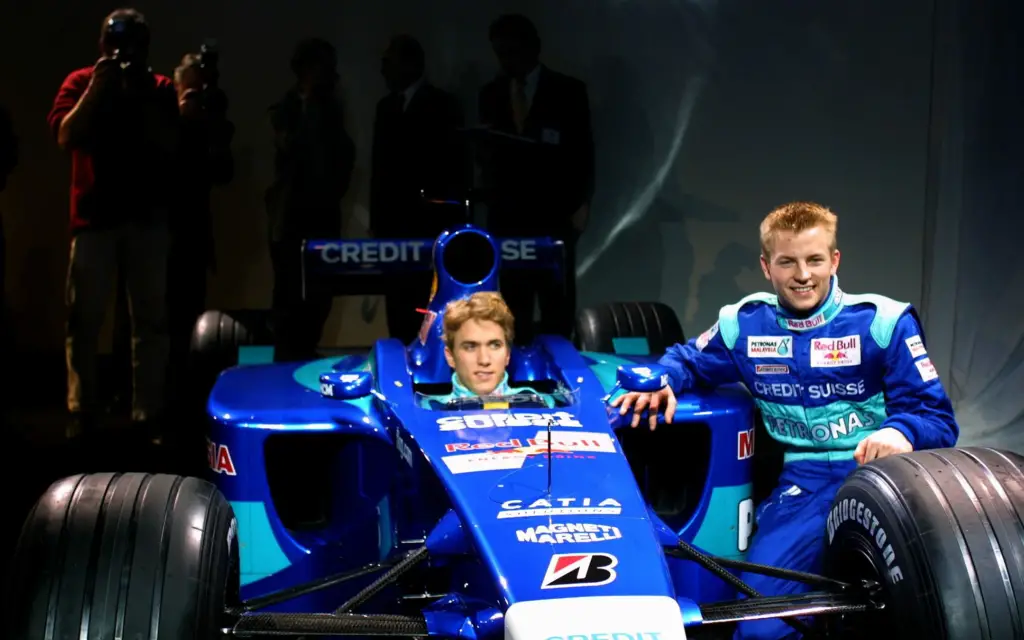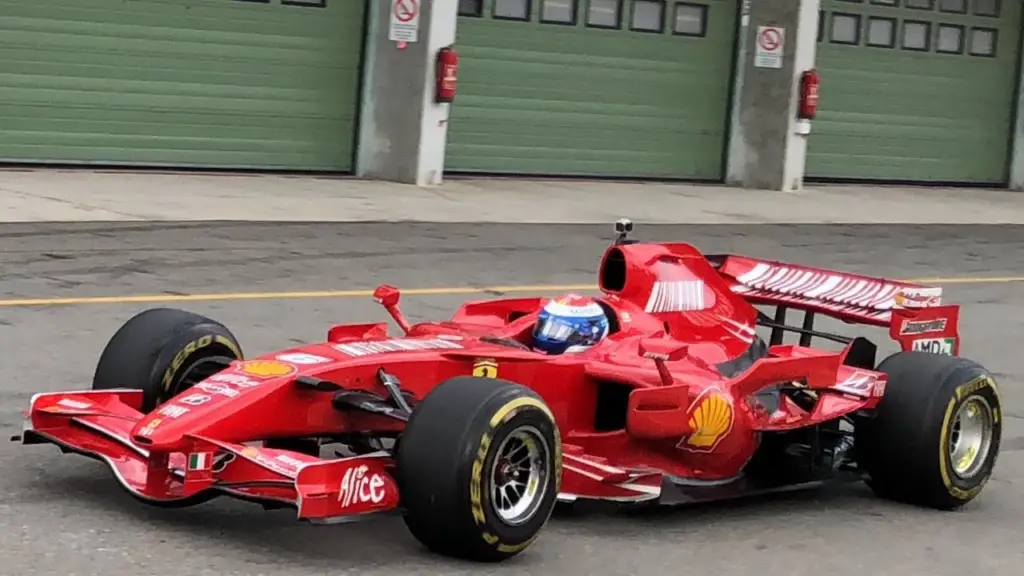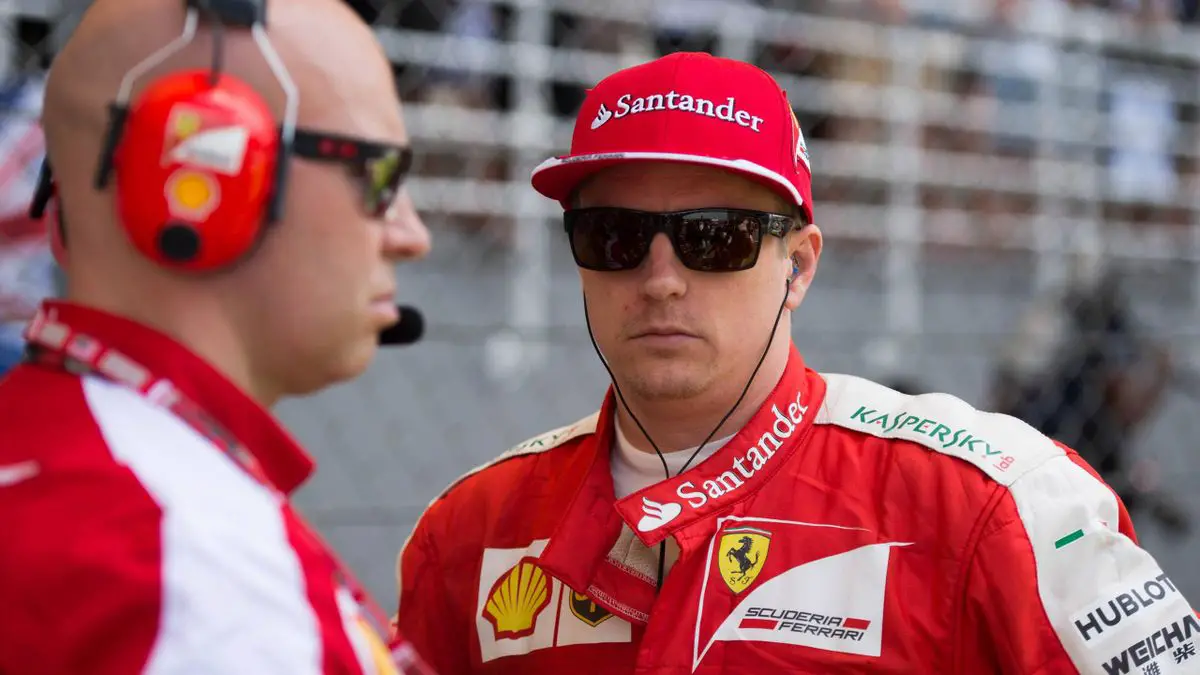Kimi Raikkonen, often fondly referred to as “The Iceman,” is a name that resonates with Formula 1 racing enthusiasts worldwide. Born in Espoo, Finland, on October 17, 1979, this unflappable driver has carved his niche in the annals of motorsport history.
This article delves into the life and career of Kimi Raikkonen, tracing his origins, family background, and his remarkable journey through the world of Formula 1 racing.
F1worldwide.com also recommends the following Articles
- Sebastian Vettel: Career Highlights, F1 Accomplishments and Rise to Stardom
- The History of Formula One Racing: From the 1950s to Today
- The Top F1 Rivalries: A Look Back at the Most Intense Battles
- All the F1 Champions Since 1950
- The Tragic Reality: F1 Drivers Who Have Died
Early Life and Education
Kimi-Matias Räikkönen, the second of three children, was born to Matti and Paula Räikkönen. His father, Matti, was a road builder, while his mother, Paula, worked as a secretary.
Kimi’s has two sibling
- Older brother Rami
- Younger sister Jenni
They shared his upbringing in Espoo, a city located just west of Helsinki, Finland. Growing up, the Räikkönen household was steeped in a culture of motorsports, with both parents having an interest in racing. T
his familial influence would play a pivotal role in shaping Kimi’s destiny.
Kimi’s educational journey was marked by an interest in mechanics and engineering. He attended the Sami Hyypiä Academy, named after the famed Finnish footballer Sami Hyypiä, where he received his primary education. It was during these formative years that Kimi’s passion for motorsports truly took root.
Kimi Raikkonen – The Path to Motor Racing
Kimi Raikkonen’s journey into the world of motor racing began with karting, a common starting point for many aspiring racers. He showed prodigious talent and determination on the karting track, impressing his family and peers with his innate racing instincts.
His early success in karting competitions paved the way for a transition to more competitive and faster forms of racing.
In 1998, Kimi Räikkönen made his debut in the British Formula Renault Championship, showcasing his talent on a bigger stage. His exceptional performances caught the eye of Peter Sauber, the owner of Sauber Motorsport, a Swiss Formula 1 team.
This marked the beginning of his meteoric rise in the world of Formula 1.
Kimi Raikkonen – Formula 1 Career
Kimi Raikkonen – Sauber (2001)

Räikkönen made his Formula 1 debut with Sauber in the 2001 season. His performance during his rookie year was nothing short of impressive, earning him a reputation as a rising star in the sport.
Despite racing for a mid-field team, he managed to secure his first championship points and finish the season tenth overall.
Kimi Raikkonen – McLaren (2002-2006)

In 2002, Räikkönen secured a seat at the prestigious McLaren team, partnering with David Coulthard. This marked the beginning of his partnership with McLaren, a team that would become synonymous with his career.
Over the next five years, Kimi consistently delivered stellar performances. He achieved 9 Grand Prix victories and coming close to winning the championship in 2003 and 2005.
His partnership with Juan Pablo Montoya in 2005 was marked by fierce competition and internal rivalry. It also pushed both drivers to perform at their best. Kimi finished second in the championship, narrowly losing out to Fernando Alonso.
Kimi Raikkonen – Ferrari (2007-2009)

In 2007, Kimi Räikkönen joined Scuderia Ferrari, the most prestigious team in Formula 1. In his first season with the team, he displayed remarkable consistency. He won the World Drivers’ Championship by a single point over Lewis Hamilton and Fernando Alonso.
He was the first Ferrari driver since Jody Scheckter in 1979 to win the championship.
Leaving Formula One (2010–2011)
As the 2009 Formula One season was winding down, Ferrari took the surprising step of announcing that Kimi Raikkonen, despite having a valid contract for the 2010 season, would be departing from the team.
His seat would be filled by none other than Fernando Alonso, a move that sent shockwaves through the racing world. Anticipation grew about his next destination, and many expected him to make a triumphant return to McLaren alongside Lewis Hamilton.
However, negotiations with McLaren ultimately fell apart, leaving fans and pundits speculating about the Iceman’s next move.
Räikkönen’s name was then linked to the Mercedes GP team, but to the surprise of many, Mercedes opted for the comeback of the legendary Michael Schumacher and the promising Nico Rosberg.
On November 17, 2009, Kimi Räikkönen’s manager, Steve Robertson, officially confirmed that the Finnish driver would not be participating in the Formula One championship for the 2010 season. However, the motorsport world was abuzz with rumors during the 2010 season regarding a potential Räikkönen comeback, this time with the Renault team in 2011.
This speculation gained traction due to Renault’s resurgence in form and uncertainty surrounding the re-signing of the Russian driver, Vitaly Petrov, who was paired with Robert Kubica at the time.
Kimi Raikkonen – Return to F1 – Lotus (2012-2013)

Räikkönen returned to F1 driving for Lotus in 2012 and 2013. In 2013 he finished 3rd in he drover championship.
The following year (2013) he finished 5th.
Kimi Raikkonen – Return to Ferrari (2014-2018)

Kimi Räikkönen made a comeback with Ferrari in 2014. During his second stint with the team, he played a crucial role as a support driver to Sebastian Vettel.
He played a strong role in helping the team in its pursuit of the Constructors’ Championship.
Kimi Raikkonen – Alfa Romeo (2019-2021)
In 2019, Räikkönen moved to Alfa Romeo Racing (formerly Sauber), marking a return to his roots in a team that had been rebranded.
While the team was not a front-runner, Kimi continued to display his racing prowess, scoring points and contributing to the team’s development.
Partnerships and Successes
Throughout his career, Kimi Raikkonen partnered with several notable drivers, including the following.
- David Coulthard
- Juan Pablo Montoya
- Felipe Massa
- Fernando Alonso
- Sebastian Vettel.
These partnerships were characterized by fierce competition, mutual respect, and, in some cases, intense rivalries. Notably, his partnership with Juan Pablo Montoya at McLaren and later with Sebastian Vettel at Ferrari were marked by intense intra-team battles.
Kimi’s career highlights include his World Drivers’ Championship victory with Ferrari in 2007, where he displayed his unrivaled consistency and ability to perform under pressure. He also holds the record for the fastest lap in a Formula 1 race, achieved at the 2018 Italian Grand Prix.
Challenges and Controversies
Kimi Räikkönen’s career has not been without its fair share of challenges and controversies. He is known for his straightforward and no-nonsense approach, often shunning the media spotlight and delivering monosyllabic responses during interviews.
This earned him the moniker “The Iceman.” While this stoic demeanor has its charm, it has also led to criticism from some quarters for his perceived lack of enthusiasm.
In terms of controversies, one notable incident occurred during his time at McLaren when his car was disqualified from the 2003 Brazilian Grand Prix due to a technical irregularity.
Additionally, his crash at the 2005 European Grand Prix sparked controversy and debate within the Formula 1 community.
Kimi Raikkonen Wife

Beyond the racetrack, Kimi Raikkonen leads a relatively private life. In 2004, he tied the knot with Jenni Dahlman, a Finnish model and former Miss Scandinavia.
The couple welcomed their first child, a son named Robin, in 2015. Kimi’s commitment to family is evident in his decision to skip the 2017 United States Grand Prix to be with his wife for the birth of their second child, a daughter named Rianna.
Conclusion
Kimi Räikkönen’s journey from karting in Finland to Formula 1 stardom is a testament to his exceptional talent, resilience, and determination.
His partnership with various teams and drivers, along with his successes and controversies, have solidified his status as a legendary figure in the world of motorsports.
The Iceman’s legacy transcends his unemotive exterior, leaving an indelible mark on Formula 1 history that will be remembered for generations to come.

